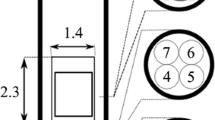Abstract
The questions of a correlation between normative and operational quantities in the dosimetry of ionizing radiation still attract the attention of professionals working in the field. Since the neutron fields of nuclear-physics facilities at the Joint Institute for Nuclear Research (JINR) are highly varied, the question of whether the ambient neutron dose always serves as a conservative estimate of the effective dose (in the terms of which the dose limits are set) is of practical importance for radiation monitoring at JINR. We studied the correlation between the calculated values of effective and ambient neutron doses obtained based on a representative set of neutron spectra measured at JINR with the use of a multisphere neutron spectrometer. It is demonstrated that measuring the ambient neutron dose may not serve as a confirmation of compliance with the set dose limits in “hard” neutron fields.
Similar content being viewed by others
References
Radiation Safety Standards NRB-99/2009 (Federal’nyi Tsentr Gigieny i Epidemiologii Rospotrebnadzora, Moscow, 2009) [in Russian].
“ICRP Publication 74. Conversion coefficients for use in radiological protection against external radiation,” Ann. ICRP 26(3–4), 1–205 (1996).
K. Eckerman, J. Harrison, H.-G. Menzel, and C. H. Clement, “ICRP Publication 119. Compendium of dose coefficients based on ICRP Publication 60,” Ann. ICRP 41(s1), 1–130 (2012).
M. Pelliccioni, “Overview of fluence-to-effective dose and fluence-to-ambient dose equivalent conversion coefficients for high energy radiation calculated using the FLUKA code,” Radiat. Prot. Dosim. 88, 279–297 (2000).
L. G. Beskrovnaya, E. A. Goroshkova, and Yu. V. Mokrov, “An investigation into the accuracy of the albedo dosimeter DVGN-01 in measuring personnel irradiation doses in the fields of neutron radiation at nuclear power installations of the joint institute for nuclear research,” Phys. Part. Nucl. Lett. 7, 212–221 (2010).
A. G. Alekseev and V. N. Lebedev, “A study into methodological problems related to the use of individual albedo-type neutron dosimeters,” Preprint IHEP 2003-8 (Institute for High Energy Physics, Protvino, 2003).
Author information
Authors and Affiliations
Corresponding author
Additional information
Original Russian Text © S.V. Guseva, E.N. Lesovaya, G.N. Timoshenko, 2015, published in Pis’ma v Zhurnal Fizika Elementarnykh Chastits i Atomnogo Yadra, 2015.
Rights and permissions
About this article
Cite this article
Guseva, S.V., Lesovaya, E.N. & Timoshenko, G.N. Correlation between effective and ambient neutron doses in radiation fields of nuclear-physics facilities at the joint institute for nuclear research. Phys. Part. Nuclei Lett. 12, 184–189 (2015). https://doi.org/10.1134/S1547477115010124
Published:
Issue Date:
DOI: https://doi.org/10.1134/S1547477115010124




